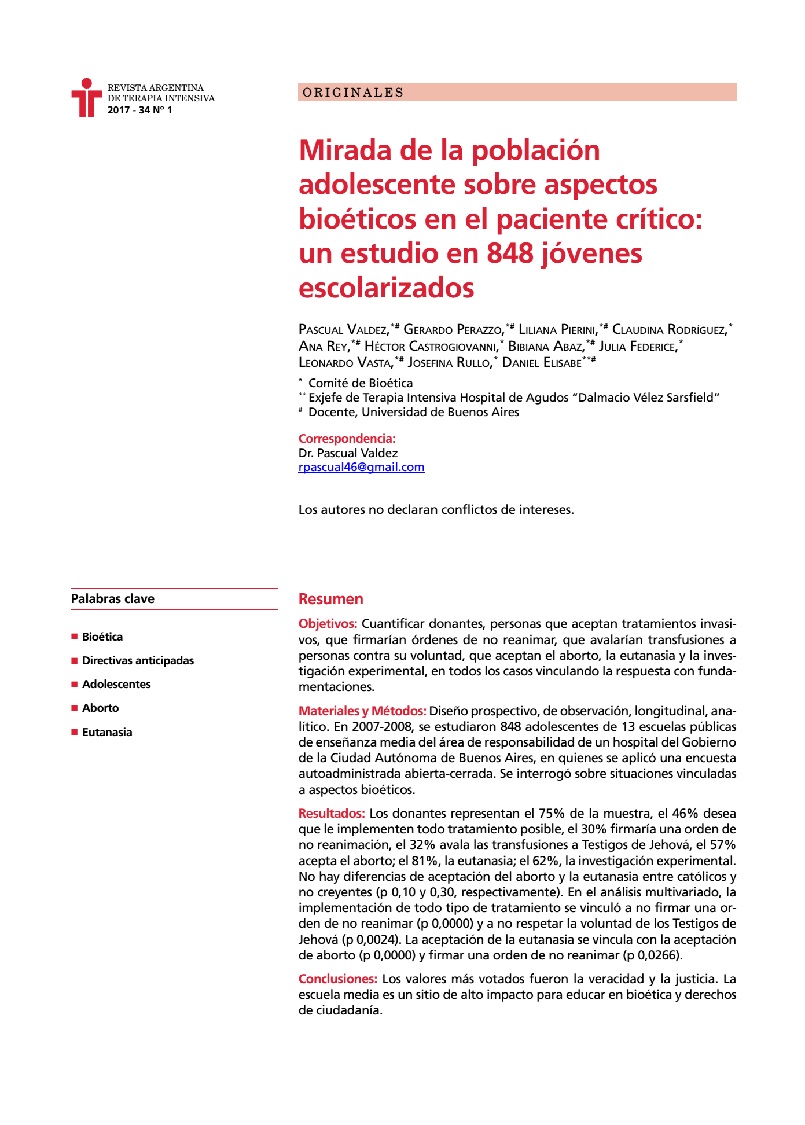Abstract
Objetivos: Cuantificar donantes, personas que aceptan tratamientos invasivos, que firmarían órdenes de no reanimar (ONR), que avalarían transfusiones a personas contra su voluntad, que aceptan el aborto, la eutanasia, e investigación experimental, en todos los casos vinculando la respuesta con fundamentaciones.
Material y métodos: Diseño prospectivo, observacional, longitudinal, analítico. En 2007-2008 se estudiaron 848 adolescentes de 13 escuelas públicas de enseñanza media del área de responsabilidad de un hospital del GCBA, en quienes se aplicó una encuesta autoadministrada abierta- cerrada. Se interrogó sobre situaciones vinculadas a aspectos bioéticos.
Resultados: Los donantes representan el 75% de la muestra, el 46% desea que le implementen todo tratamiento posible, el 30% firmaría ONR, el 32% avala transfusiones a Testigos de Jehová, el 57% acepta el aborto, el 81% la eutanasia, el 62% la investigación experimental. No hay diferencias de aceptación de aborto y eutanasia entre católicos y no creyentes (p 0.10 y 0.30 respectivamente). La implementación de todo tipo de tratamiento se vinculó en el análisis multivariado a no firmar ONR (p 0.0000) y a no respetar la voluntad de los Testigos de Jehová (p 0.0024). La aceptación de eutanasia se vincula en el análisis multivariado con aceptar el aborto (p 0.0000) y firmar ONR (p 0.0266).
Conclusiones: Hay votación mayoritaria a favor de la veracidad y la justicia. La escuela media es un sitio de alto impacto para educar en bioética y derechos de ciudadanía.
References
- Cohen D. Temas de Bioética para inquietos morales. 2004. Ediciones del signo. Buenos Aires. Argentina.
- Elisabe D, Vasta L, Pierini L, Albornoz M, Pose A, Fukuda C, Zelechower H, Santoro M, Orlando G, Valdez P. Bioética y medicina crÃtica: escuchemos a los usuarios. Medicina Intensiva 2006; 23: 24-25
- Castagna R, Pose A, Izrastzoff T, Albornoz M, Mardyks M, Valdez P. Procuración de órganos y tejidos: Dificultades para la implementación de la misma. Revista de NefrologÃa, Diálisis y Transplante 2001; 55: 3-19.
- Acro A, Aquino V, Didia Attlas J, Raggi S, Varsavsky G. Trasplante de órganos. Enfoque médico, psicológico, legal, filosófico, ético, religioso, social y económico. BoletÃn CientÃfico AMM 2001; 27: 1-8.
- Shepardson LB, Gordon HS, Ibrahim SA, Harper DL, Rosenthal GE. Racial variation in the use of do-not-resuscitate orders. J Gen Intern Med 1999;14:15-20.
- Post LF, Blustein J, Dubler NN. The doctor-proxy relationship: an untapped resource: introduction. Journal of Law and Medical Ethics. 1999;27:5–12.
- Martin DK, Emanuel LL, Singer PA. Planning for the end of life. Lancet. 2000;356:1672–1676.
- Phipps E, True G, Harris D, Chang U, Tester W, Chavin SI, Braitman LE. Approaching the end-of-life: Attitudes, preferences, and behaviors of African-American and White patients and their family caregivers. Journal of Clinical Oncology. 2003;21:549–554.
- Bowman KW, Singer PA. Chinese seniors' perspectives on end-of-life decisions. Social Science and Medicine. 2000;53:455–464.
- Vaughn G, Kiyasu E, McCormick WC. Advance directive preferences among subpopulations of Asian nursing home residents in the Pacific Northwest. Journal of American Geriatrics Society. 2000;48:554–557.
- Doorenbos AZ. The use of advance directives in population of Asian Indian Hindus. Journal of Transcultural Nursing. 2003;14:17–24.
- Frank G, Blackhall LJ, Michel V, Murphy ST, Azen SP, Park K. A discourse of relationships in bioethics: patient autonomy and end-of-life decision making among elderly Korean Americans. Med Anthropol Q 1998; 12: 403-423.
- Blackhall LJ, Frank G, Murphy S, Michel V. Bioethics in a different tongue: the case of truth-telling. J Urban Health 2001;78:59-71.
- Akabayashi A, Slingsby BT. International perspectives, Biomedical ethics in Japan: The second stage. Cambridge Quarterly of Healthcare Ethics. 2003;12:261–264.
- Okuno S, Tagaya A, Tamura M, Davis A. Elderly Japanese people living in small towns reflect on end-of-life issues. Nursing Ethics. 1999;6:308–315.
- The Prime Minster's Office Japan. Iryou ni okeru rinri ni kansuru yoronchousa (Consensus Survery Concerning Ethics in Medical Treatment). 1990. (in Japanese).
- Ministry of Health. Makkiiryou ni kansuru kokumin no ishikichousa nado kentoukai houkokusho (Investigative Committee's Survey Report on the People's Consciousness Concerning Terminal Care). 1993. (in Japanese).
- Akabayashi A, Kai I, Itoh H, Tukui K. The acceptability of advance directives in Japanese society: A questionnaire study for healthy people in the physical check-up settings. Journal of Japan Association for Bioethics. 1997;7:31–40. (in Japanese).
- Akabayashi A, Slingsby BT, Kai I. Perspectives on advance directives in Japanese society: A population-based questionnaire survey. BMC Med Ethics 2003; 4:E5.
- Akabayashi A, Fetters M, Elwyn T. Family consent, communication, and advance directives for cancer disclosure: a Japanese case and discussion. Journal of Medical Ethics. 1999;25:296–301.
- Hoshino, K. Informed consent: six proposals that fit Japan (in Japanese). Tokyo: Maruzen; 1997.
- Asai A. Should physicians tell patients the truth? Western Journal of Medicine. 1995;163:36–9.
- Helou A, Wende A, Hecke T, Rohrmann S, Buser K, Dierks ML. Public opinion on active euthanasia. The results of a pilot project. Dtsch Med Wochenschr 2000;125:308-315.
- Nyhsen C, Weber M, Schuz J, Faust G. Dying through the hand of man or taken by the hand of man? Results of an opinion poll concerning active euthanasia and the Hospice Movement. Med Klin (Munich) 1999; 94:536-540.
- Cook DJ, Guyatt G, Rocker G, Sjokvist P, Weaver B, Dodek P, Marshall J, Leasa D, Levy M, Varon J, Fisher M, Cook R. Cardiopulmonary resuscitation directives on admission to intensive-care unit: an international observation study. Lancet. 2001;358:1941–1945.
- Jinich P. Embarazo no buscado. En Rubinstein A y col. Panamericana 2001. Pp:. 439-441.
- Schwarcz R, Galimberti D y col. GuÃa para el uso de métodos anticonceptivos. Dirección Nacional de Salud Materno Infantil. Ministerio de Salud. 2003.
- http://www.mpf.gov.ar/dictamenes/2011/casal/abr/f_aurora_f_259_l_xlvi.pdf Fallo de la Corte Suprema. Buenos Aires, 13 de marzo de 2012.
The magazine does not retain the reproduction rights (copyright) so the authors can republish their works with the sole mention of the original publication source.

